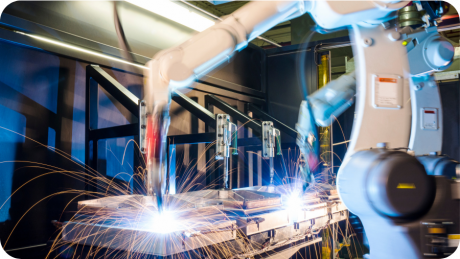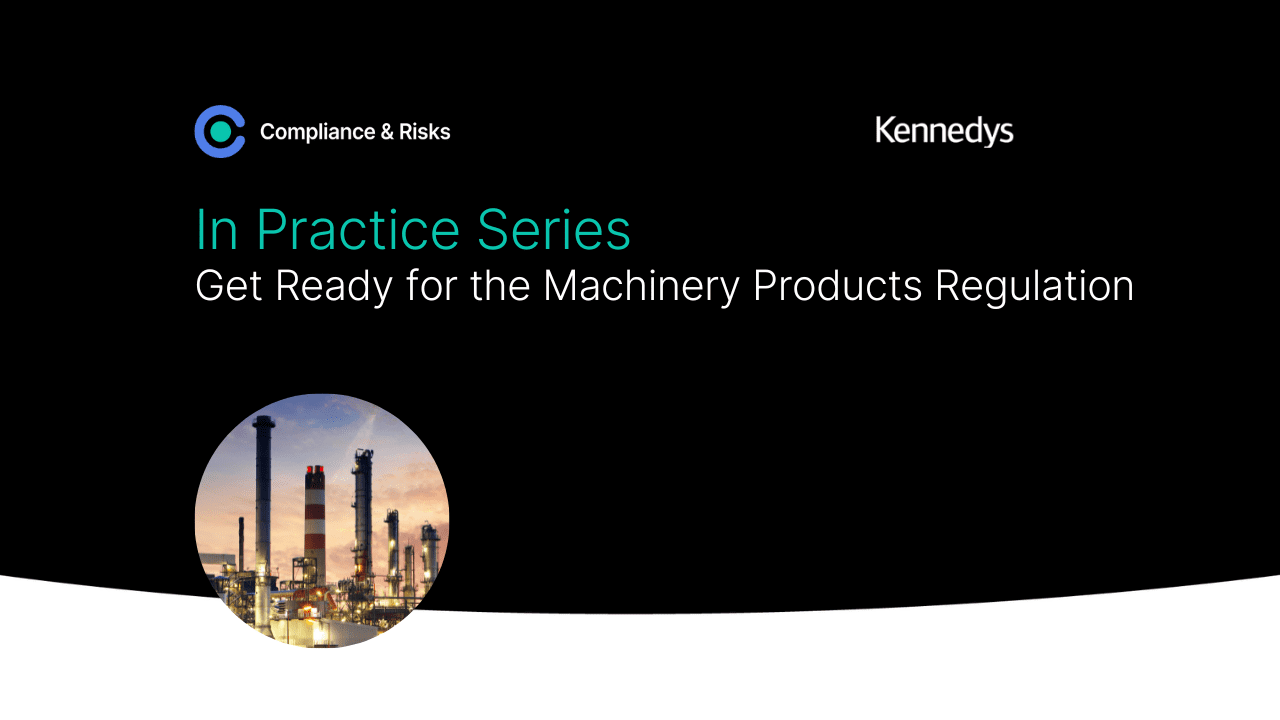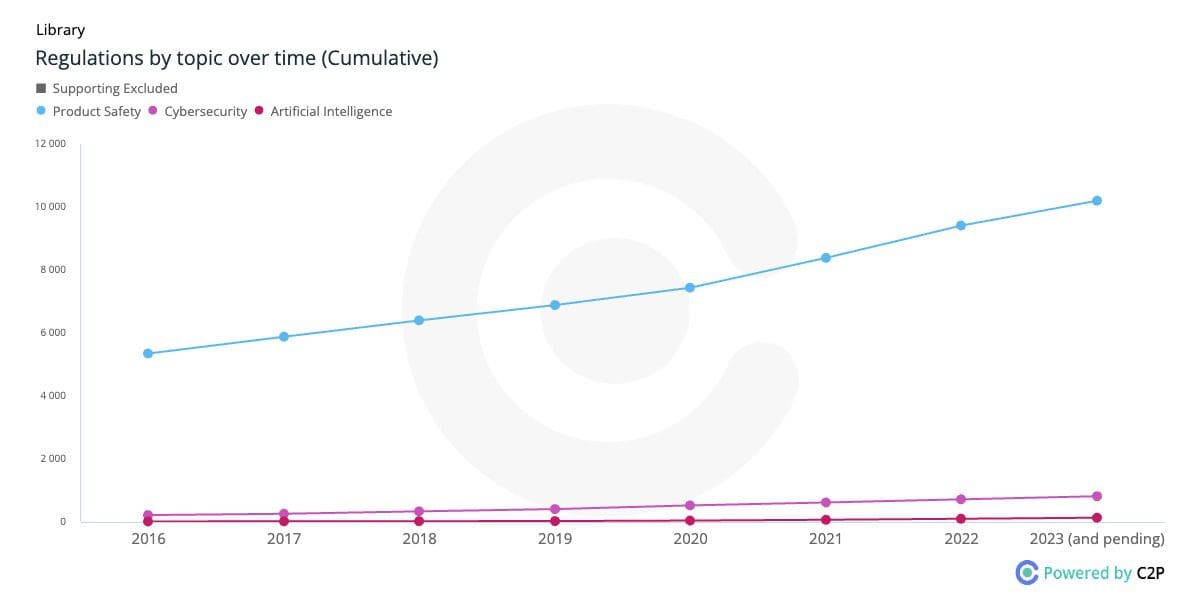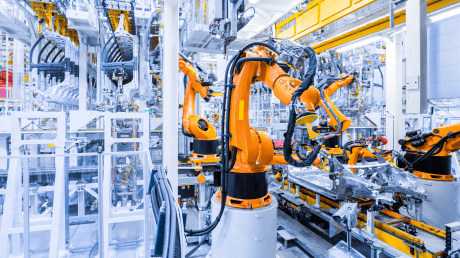
Get Ready for the Machinery Products Regulation

This blog was originally posted on September 13th, 2023. Further regulatory developments may have occurred after publication. To keep up-to-date with the latest compliance news, sign up to our newsletter.
OUR MONTHLY “IN PRACTICE SERIES” IS BROUGHT TO YOU IN PARTNERSHIP WITH KENNEDYS LAW LLP
TO HELP ENSURE YOU HAVE ACCESS TO PRACTICAL INSIGHTS BACKED BY OUR COMPREHENSIVE, IN-DEPTH REGULATORY EXPERTISE.
AUTHORED BY: SARAH-JANE DOBSON, PARTNER, Thomas Panter, Legal Directive, Miran Bahra; ASSOCIATE AND TEGAN JOHNSON; SOLICITOR APPRENTICE KENNEDYS LAW LLP
Potential Limitations to the Machinery Directive 2006/42/EC
The Machinery Directive 2006/42/EC (the “Machinery Directive”), which was published on 9 June 2006, has been the core European legislation regulating products of the mechanical and engineering industries for almost 20 years.
The European Commission (“EC”) has flagged the Machinery Directive for revision as far back as May 2018, when it published a Staff Working Document to analyze the current performance of the Machinery Directive to ensure it was fit for purpose in line with other EU regimes and policies, and the evolution of digital technologies. The Staff Working Document identified a number of concerns:
- The ability of the Machinery Directive to cover future digital technologies, such as Artificial Intelligence (“AI”) and the Internet of Things (“IoT”).
- The effectiveness of market surveillance and enforcement in relation to non-compliance;
- The disproportionate administrative costs arising from certain requirements, such as documentation, which could be simplified.
- The overlap or inconsistency with other EU specific regimes, with a need for greater legal clarity in scope and definitions.
The approach to revising the Machinery Directive was further matured through the EC Work Programme and White Paper on AI, both published in early 2020, which highlighted the limitations of the existing safety legislation, including the Machinery Directive and the policy objective to make a “Europe fit for the digital age”.
Legal Framework
The Machinery Products Regulation EU 2023/1230 (the “Regulation”) was published in the Official Journal on 29 June 2023 and will replace the Machinery Directive which will continue to apply until 14 January 2027. However, certain provisions of the Machinery Products Regulation will apply before that date. The key changes to the mainstay obligations include:
| Subject Matter and Scope | – Lays down the essential health and safety requirements for the design and construction of machinery, related products (such as interchangeable equipment, lifting accessories, chains, ropes, webbing, and removable mechanical transmission devices) and partly completed machinery. – The Machinery Directive previously limited the application of essential health and safety requirements in respect of the environment, where applicable, to machinery for pesticide application. No such product category limitation applies to the Regulation and therefore it applies to all machinery and related products, where applicable. There has been further clarification in respect of the scope of when the Regulation does not apply, for example to: – Safety components intended for use as spare parts in set circumstances; – Specific equipment for use in fairgrounds or amusement parks; – Machinery specifically designed for use in a nuclear installation; – Weapons or machinery for police or military use; – Means of transport by air, water or rail (except for machinery mounted on those means), aeronautical parts, motor vehicles, trailers and tractors and their systems/components, sea going vessels and offshore units; and – Certain electrical and electronic products covered by other EU directives, such as the Low Voltage Directive and Radio Equipment Directive, and high-voltage switchgear, control gear and transformers. |
| Key Definitions | The definitions within the Regulation have been expanded to address emerging digital technologies and the respective obligations of economic operators, as follows: Definition of Machinery This has been extended to include an assembly within the meaning of the original Machinery Directive but missing only the uploading of software intended for the specific application foreseen by the manufacturer. Definition of Safety Component This has been extended to include both physical or digital components, including software, designed or intended to fulfil a safety function. Definition of Economic Operator The revised framework brings the definitions of economic operators in line with other safety regimes and now includes the role of importer and distributor not previously within the existing regime, in addition to that of manufacturer and authorized representative. |
| Essential Health and Safety Requirements (EHSRs) | The Regulation introduces additional EHSRs, including in respect of the installation of lifting appliances, slow speed lifts, seating, protection of hazardous substances and vibration from portable handheld and hand-guided machinery. |
| Obligations of a Manufacturer | The Regulation now sets out the specific obligations for Economic Operators in Chapter II divided by role, including for manufacturers, authorized representatives, importers and distributors. Those familiar with other, more recently drafted, harmonized EU legislation will note the layout and obligations mirror those in large parts. The mainstay obligations for a manufacturer of machinery and related products are as follows: Main Obligations Ensure products have been designed and constructed in accordance with the EHSRs. Before placing a product on the market or putting it into service, manufacturers shall draw up the technical documentation and carry out the relevant conformity assessment procedures. Ensure that procedures are in place to ensure that the product remains in conformity with the Regulation. Traceability As a minimum a designation of the product model, series or type, the year of construction, and any batch or serial number or other element allowing its identification that exists should be added to a label; The manufacturer’s name, registered trade name or registered trademark, and the postal address and website, e-mail address or other digital contact at which they can be contacted should also be added to a label; The label should be affixed on the product or, where that is not possible, on its packaging or in a document accompanying the machinery or related product in a language easily understood by users and market surveillance authorities. Instructions for Use / Technical Documentation / Declaration of Conformity “Instructions for Use” are defined in greater detail and the Regulation now includes the option to provide them in a digital format as an alternative to paper, subject to specific requirements including the provision upon request in paper format free of charge. In the case of a product intended for non-professional users or that can, under reasonably foreseeable conditions, be used by non-professional users, safety information that is essential for using it in a safe way shall be provided in a paper format. The product should be accompanied by the declaration of conformity or the internet address where it can be accessed in the instructions for use. Complaints / Corrective Action The Regulation prescribes more onerous conditions with respect to complaints and corrective actions, again mirroring in format much EU harmonized legislation. Where appropriate, a register of complaints, non-conforming products and product recalls shall be kept, and distributors should be informed of any such monitoring. Manufacturers of non-conforming products shall immediately take the corrective actions necessary to bring it into conformity, withdraw it or recall it, as appropriate. Furthermore, where the product presents a risk to the health or safety of persons, domestic animals, property, and/or to the environment, economic operators must immediately inform the competent national authorities of the Member States in which they made the machinery or related product available on the market. Upon a request from a competent national authority, all the information and documentation necessary to demonstrate the conformity of the products with the Regulation should be provided, in a language which can be easily understood by that authority. Please note that further requirements under the Regulation are applicable for partly completed machinery. |
| Substantial Modification of Machinery or a Related Product | Any natural or legal person that carries out a substantial modification of machinery or a related product shall be considered to be a manufacturer and shall be subject to the obligations in respect of the same. |
The Regulatory Trend

Interplay with Cyber Security and AI
| Cyber Security | The recitals of the Regulation specifically states that: – In respect of other risks related to new digital technologies that have an impact on the safety of products, manufacturers should be required to adopt proportionate measures which are limited to the protection of the safety of the product within the scope of the Regulation. – With a view of addressing the risks stemming from malicious third party actions that have an impact on the safety of products within the scope of the Regulation, the Regulation should include EHSRs in respect of which conformity to the appropriate extent can be presumed as a result of a certificate or statement of conformity under a relevant cybersecurity certification scheme adopted in accordance with Regulation (EU) 2019/881 on Cybersecurity. The Regulation itself notes, under a presumption of conformity, that: – Machinery and related products that have been certified or for which a statement of conformity has been issued under a cybersecurity certification scheme, adopted in accordance with Regulation (EU) 2019/881 on Cybersecurity (the references of which have been published in the Official Journal of the EU) shall be presumed to be in conformity with the EHSRs set out in Annex III as regards protection against corruption and safety and reliability of control systems insofar as those requirements are covered by the cybersecurity certificate or statement of conformity or parts thereof. |
| AI | – The recitals of the Regulation specifically reference the EC’s White Paper on AI dated 19 February 2020 and confirms that the Regulation should cover the safety risks stemming from new digital technologies. – Annex I of the Regulation lists the categories of machinery products that are subject to specific conformity assessment procedures, such as safety components or machinery with fully or partially self-evolving behaviour using machine learning approaches ensuring safety functions. |
Consequences
The Regulation empowers Member States to lay down the rules on penalties applicable to the infringements by economic operators. The penalties provided for shall be “effective, proportionate, and dissuasive and may include criminal penalties for serious infringements”.
Checklist to improve compliance:
- Assess the revised scope of the legislation to determine products likely to fall within the regulation, and the implications.
- In particular, consider undertaking an environmental impact assessment of the portfolio, noting the essential health and safety requirements in respect of the environment now apply broadly to all products falling under the Regulation.
- Consider whether your products fall within Annex I of the Regulation which requires specific conformity assessment procedures to be followed.
- Identify whether your business will fall within the definition of an economic operator under the Regulation, and what corresponding obligations are applicable as a result. Be mindful that the definition of a manufacturer under the regulation can capture entities other than the physical manufacturer and who might not consider themselves the “manufacturer” of a product in other circumstances including, for example, customs and taxation.
- Consider whether your products will be subject to the additional EHSRs contained within the Regulation, including those in respect of cybersecurity and AI.
- Ensure that the traceability requirements applicable to your business in the distribution chain are implemented prior to placing a product on the market, including a register of complaints, non-conformances, monitoring and due-diligence systems. Working with your supply chain and streamlining this process will assist should non-conformances or incidents emerge in the future.
- Consider whether your business will now provide instructions for use in a digital format and the requirements in respect of the same under the Regulation.
Stay Compliant With Global Regulations
Catch up with our previous editions of our In Practice Series –
- Get Ready For The Deforestation-Free Products Regulation
- How To Avoid “Greenwashing”
- How To Be An ESG-Conscious Product Manufacturer
- How To Get Ready For The New Product Liability Laws In Europe
- How To Prepare For The Upgraded Digital Services Laws In Europe
- The Future Medical Device Regulations Within The UK
- Sustainability Initiatives At EU Level – The Current Status
- Human And Fundamental Rights Violations In Supply Chains – What Can Responsible Businesses Do?
- Construction Products And Sustainability – What’s Expected?
- Ecodesign Requirements – What’s New?
Stay Updated on All-Things Machinery!
Gain valuable insights into the Machinery Products Regulation, its impact on placing machinery products in the EU market, and the necessary preparations for the years ahead.
Watch on-demand now!







